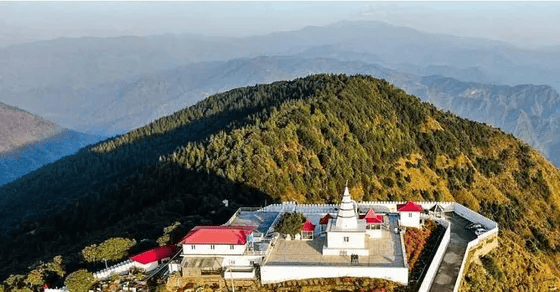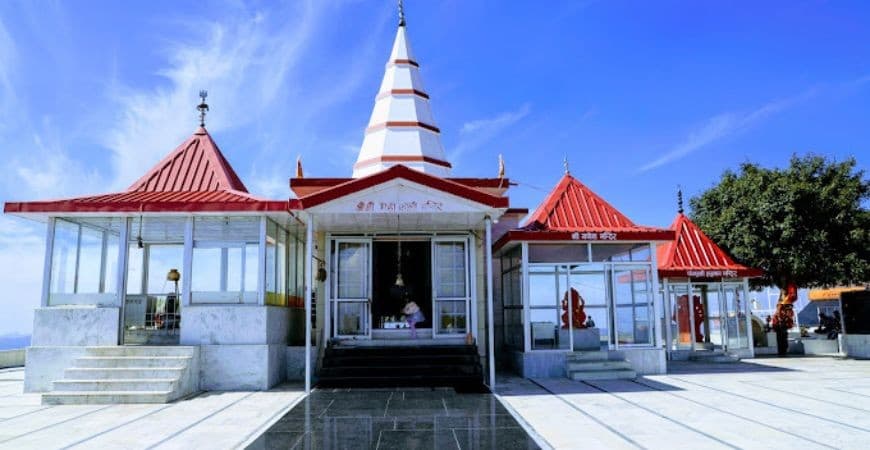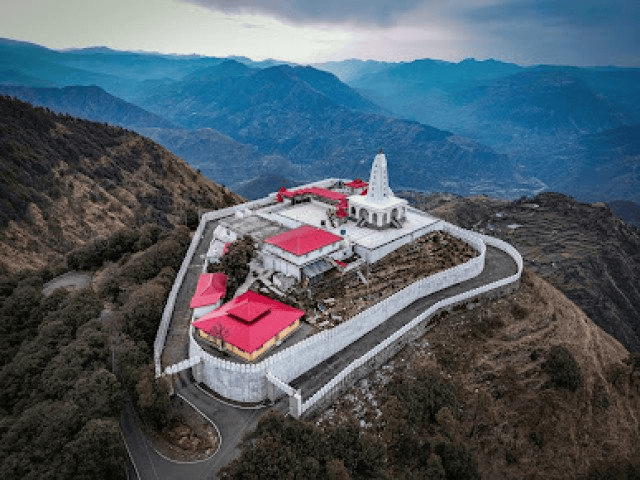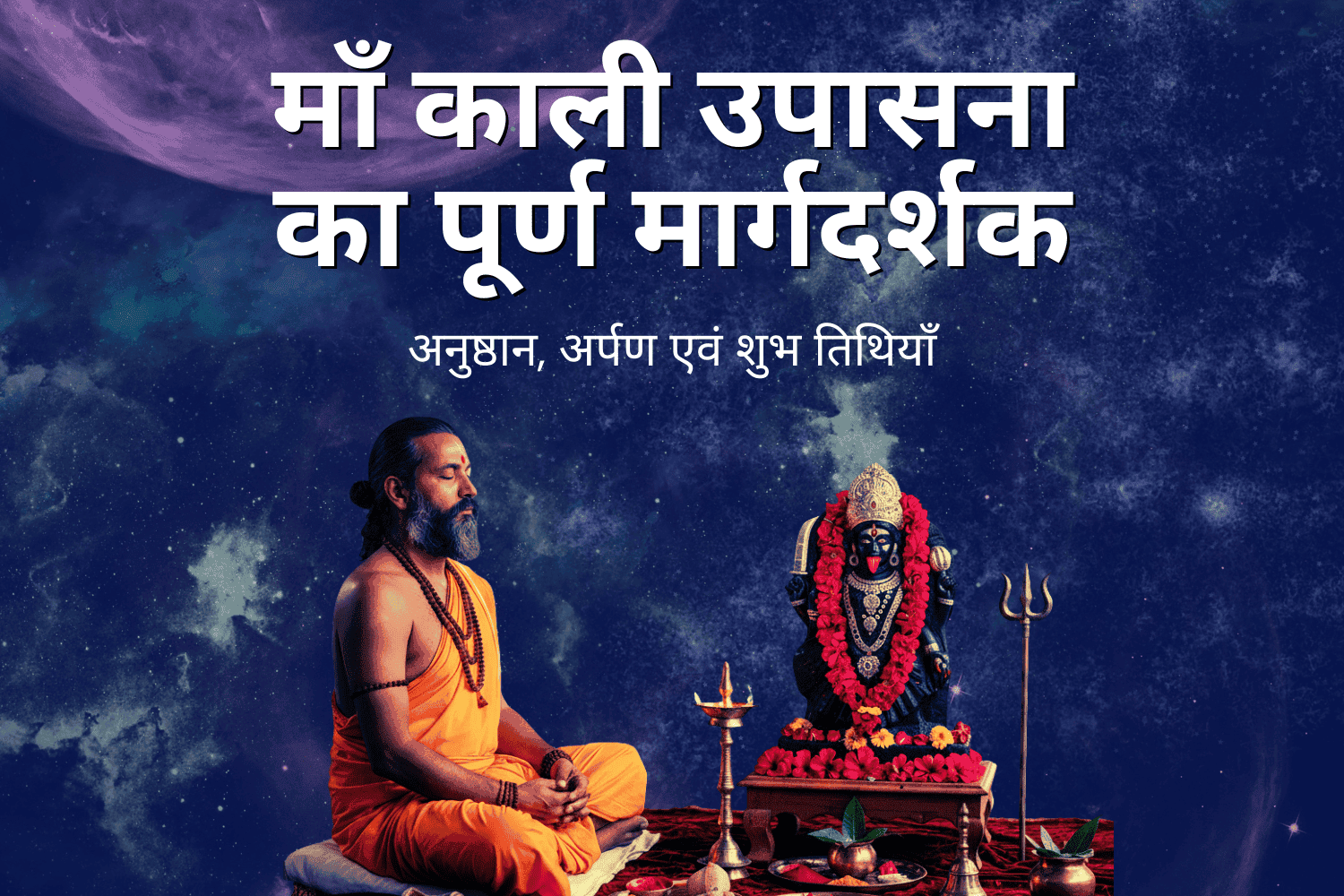In this article, you’ll read about:
🕉️ The divine origins of Kali Ka Tibba.
🏔️ The temple’s location and natural splendour.
🏛️ The marble architecture and sacred shrines inside the temple.
🌧️ Miraculous stories and divine interventions witnessed at the temple.
🙏 Saints, rituals, and daily worship, including Aarti, Parikrama, and the rhythm of devotion at the temple.
🚶♀️ The pilgrimage experience and modern preservation for this living temple of Mahakali.
Kali Ka Tibba, poised atop a tranquil Himalayan hill in Chail, Himachal Pradesh, is more than just a revered temple—it's a tapestry of legend, architecture, devotion, and natural wonder that has captured the hearts of countless devotees and travellers.

The Birth of a Legend: History of Kali Ka Tibba
Perched on a serene Himalayan hill in Chail, Himachal Pradesh, Kali Ka Tibba is not just a temple — it’s a living symbol of devotion, legend, and divine energy. The temple, dedicated to Mahakali, draws pilgrims and travellers from across the world who seek Her blessings and the peace of Her sacred abode.
The story of Kali Ka Tibba begins in ancient times, enveloped in mist and myth.
According to legend, Ma Kali appeared to a 9th-century king of Himachal Pradesh in a dream, commanding him to build a shrine in Her honour. The king, moved by this divine vision, constructed a humble shrine on the hilltop — a space chosen for its spiritual potency and isolation.
Over centuries, this secluded place of worship evolved with the devotion of countless seekers.
In the 19th century, the King of Patiala secretly funded the construction of a grander structure, fearing disputes among different sects but determined to honour Ma Kali’s command.
A turning point in modern times came with Shambhu Bharti, a deeply devoted Pujari, who transformed the site into the majestic temple we see today. He built new pathways for pilgrims, established sacred pools, and fortified the hill with protective walls — all while preserving its spiritual sanctity.
Thanks to these efforts, Kali Ka Tibba became recognized as one of the 51 Shakti Peethas, a revered network of shrines dedicated to the Divine Feminine.
Today, the temple stands not only as a spiritual centre but also as a beacon of faith, transformation, and timeless worship.
The Sacred Setting: Location and Natural Splendour
Perched at approximately 2,226 meters (7,500 feet) above sea level, Kali Ka Tibba stands as the highest point in Chail—a vantage point that feels closer to the heavens and, perhaps, to Mahakali Herself.

The view from the temple is breathtaking. Snow-dusted peaks of the Shivalik Range shimmer in the distance, the mighty Choor Chandni mountain looms protectively nearby, and on clear days, one can glimpse the silhouettes of Shimla and the valleys beyond.
Reaching the temple is a gentle and rewarding journey. Visitors can take a short, scenic trek from the parking area, winding through lush Deodar forests and breathing in the crisp Himalayan air. Along the way, bird calls echo through the trees, heightening the sense of sacred stillness.
Despite its elevation, Kali Ka Tibba is easily accessible by road from Chail. Ample parking, well-maintained pathways, and peaceful gardens make the visit both convenient and spiritually enriching.
Marvel in Marble: Architecture of Kali Ka Tibba
The present-day Kali Ka Tibba temple, sculpted in pristine white marble, rises in elegant contrast against the lush green hillsides of Chail.
Its architecture is a graceful blend of traditional Himachali design and thoughtful functionality. Domes, pillared courtyards, and intricate carvings echo the devotional spirit that has shaped this sacred site through the centuries.

Source: sterlingholidays.com
Unique to Kali Ka Tibba is the presence of multiple shrines within the temple complex.
Alongside the main sanctum of Mahakali, devotees can offer prayers at smaller yet significant shrines dedicated to Panchmukhi Hanuman, Lord Ganesh, and Lord Shiva. Each one is modest in scale but immense in spiritual resonance.
At the heart of the temple lies the sanctum sanctorum, housing a powerful idol of Mahakali installed during the major renovation in 2003. Before this, worship centered around a pind—a natural stone representation of Ma Kali—imbued with centuries of devotion and myth.
Today, the temple’s open layout invites sunlight and mountain winds to dance through the corridors, creating a space that feels both energized and deeply serene.
Legends and Miracles: Stories of Kali Ka Tibba
Kali Ka Tibba is a place of living stories.
Local elders whisper of people who arrived with heavy burdens and left relieved, of prayers answered against all odds, and of a Goddess who listens.
The temple's reputation as a wish-fulfilling shrine draws thousands each year. It is widely believed that sincere prayers at Ma Kali’s feet never go unheard.
The King’s Dream
Long ago, a king of Himachal was haunted by recurring dreams of a fierce and compassionate Goddess. In one vision, Ma Kali commanded him to honour Her by building a temple at the very peak of a high, lonely hill.
He quietly obeyed, fearing tension in his divided kingdom if Her wishes were ignored. What began as a humble collection of stones gradually evolved with the devotion of later kings and villagers.
This sacred shrine watched over Chail for centuries.
Its legend spread so far that even distant seekers began dreaming of Ma Kali, their Kul Devi, calling them to Her altar—especially during times of distress or longing.
The White Marble Sanctum
The temple that stands today glistens in white marble and sits atop what locals call a Tibba—the pinnacle. Inside, the idol of Mahakali is surrounded by vivid flowers, flickering lamps, and whispered offerings of gratitude.
On the outer periphery, shrines to Lord Shiva, Lord Ganesha, and the powerful Panchmukhi Hanuman reflect the seamless tapestry of Bhakti.
Each deity guards a corner of the sanctum, but all dwell under the vigilance of the Goddess.
Monsoons and Miracles
This sacred place is not only home to radiant idols—but also to swirling clouds, silent vows, and unexpected signs. When the monsoon arrives, locals say Ma Kali’s presence swells with the storm.
There are tales of sudden mists rolling in just as a wish is uttered, or rain pouring the moment a devotee surrenders a heartfelt prayer.
One story tells of the sky clearing instantly after someone left the temple—interpreted as a divine response from Ma Kali Herself.
The Lightning During Renovation
During a renovation phase, a sudden lightning storm struck the temple. Work halted for days. Construction tools mysteriously vanished, only to reappear after the right prayers and rituals were performed.
When the restoration was finally completed, the sun returned in full glory.
Villagers believed Ma Kali Herself had signaled the completion of a sacred renewal.
Protector of the Valley
The people of Chail and nearby villages believe Ma Kali watches over their land.
During times of forest fires or harsh droughts, collective Yagnas and ceremonies at Kali Ka Tibba have reportedly brought relief—be it as unexpected rain or a sudden shift in the wind.
This protective role has made Kali Ka Tibba a deeply personal pilgrimage site for many families. They return not only for Darshan, but to express gratitude for protection, healing, and hope.
Everyday Magic
But the temple’s magic isn’t always dramatic. Sometimes, it’s in the stillness.
A gentle hum flows through the marble corridors at dusk, as if the wind through the Deodars carries Ma Kali’s voice. Many say She speaks not in words—but in presence.
Even today, whether during Navratri or on ordinary days, the temple is filled with longing and Bhakti. Pilgrims walk around the sanctum seven times, hands folded, eyes closed, carrying quiet prayers in their hearts.
Stories abound of marriages mended, fortunes turned, or peace found—just from a single visit to this mountaintop temple of Mahakali.
The Enduring Spirit of Mahakali
The tale of Kali Ka Tibba endures—not only in marble and myth, but in every cloud that wraps the summit, every dream that carries Her call, and every soul transformed beneath Her unwavering gaze.
Guided by the Wise: Saints and Spiritual Visitors
The spiritual energy of Kali Ka Tibba has long drawn not just pilgrims, but also saints and sages.
Over the centuries, many holy men—some wandering ascetics, others resident yogis—have meditated here in silence and performed powerful rituals.
While the oldest records of these saints have faded with time, oral traditions speak of their visits during key festivals and celestial alignments. These stories live on in local memory, strengthening the temple’s sacred lore.
One especially revered figure is Shambhu Bharti, a saint who played a key role in the temple’s recent development. His spiritual practices and contributions are still remembered with deep reverence by the people of Chail.
Even today, Kali Ka Tibba continues to attract seekers, spiritual guides, and quiet travellers drawn to the powerful presence of Mahakali.
Rhythm of Devotion: Daily Routine at the Temple
Each day at Kali Ka Tibba begins with the first rays of sunlight washing over its white marble façade.
The temple doors open at 8 AM and close by 6 PM, welcoming all who arrive seeking peace, Darshan, or quiet reflection.
Priests begin the day with sacred Aarti, offering fresh garlands, lighting lamps, and sounding the conch in rhythmic Bhakti.
The temple grounds slowly fill with the soft murmurs of prayers and the fragrance of incense carried by the mountain breeze.
Throughout the day, devotees walk the Parikrama path around the sanctum, offer sweets at the feet of Ma Kali, and sit in the tranquil gardens to reflect. Even the simple act of sitting here, they say, becomes a kind of Sadhana.
During festivals like Navratri, the temple comes alive with color, song, and devotion. Special Pujas, Yagnas, and Havan ceremonies are conducted, drawing hundreds of visitors who gather to honour Mahakali with heartfelt offerings.
Whether on quiet days or during grand celebrations, the rhythm of worship at Kali Ka Tibba flows with grace and sacred presence—inviting every visitor to pause, connect, and surrender.
Journey of Faith: The Pilgrimage Experience
The pilgrimage to Kali Ka Tibba is more than a physical journey—it is a spiritual ascent. Whether devotees arrive on foot or by vehicle, the final stretch is steeped in sacred anticipation.

The winding path, flanked by wildflowers and sweeping vistas, invites pilgrims to slow down and reflect. Young and old climb together, exchanging food, stories, and songs that echo with Bhakti.
During Navratri and other festivals, the temple transforms into a vibrant celebration of faith. Drums beat, bells ring, and chants rise into the mountain air as devotees seek blessings from Ma Kali.
Many believe that a single visit to Her shrine can shift one’s destiny—restoring harmony to families, igniting spiritual clarity, or unlocking long-awaited blessings.
Each step toward the sanctum feels like an offering. Every shared laugh, every prayer whispered into the wind, becomes part of the sacred tapestry of this living temple.
Kali Ka Tibba in the Modern World
Though rooted in ancient tradition, Kali Ka Tibba is also a model of modern preservation and care.
The temple grounds are meticulously maintained, offering clean washrooms, ample parking, and shops that serve the needs of pilgrims and travellers.
The management and local community share a deep commitment to cultural and environmental stewardship. Together, they ensure that the natural splendour and spiritual power of this Himalayan shrine remain intact for future generations.
This sacred site is not just a relic of the past—it is a living, breathing space of devotion.
From mystic origins whispered in legend to its present-day glow, Kali Ka Tibba continues to draw seekers from around the world.
To many, Ma Kali appears here not only as a fierce protector but also as a compassionate Mother. She is known by many names—Ma Kali, Kali Devi, Kali Mata—and remembered in countless hearts.
Today, Her temple stands serene yet powerful atop the hill, surrounded by clouds, silence, and stories. A timeless beacon for those who dare to hope, pray, and begin again.

